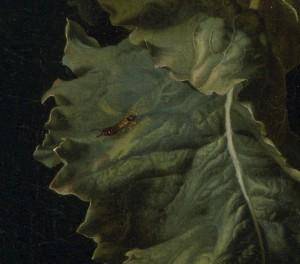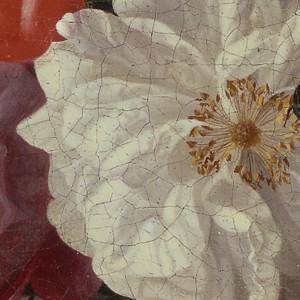Bouquet of Flowers in a Vase
- Maria van Oosterwyck, Dutch, 1630-1693
Maria van Oosterwyck was born in Holland in 1630, the daughter of a well-to-do Protestant clergyman and his wife. She never married, though she was courted by another flower painter, Willem van Aelst. According to one source, van Aelst eventually gave up because she was so devoted to her career. Female artists were rare in the 1600s, but that didn’t keep Oosterwyck from success. Her paintings were bought by royalty, including King Louis XIV of France and King William III of England, and almost always fetched high prices.
Oosterwyck’s still-life studies included a range of objects such as glassware, coins, musical instruments, and flowers. She created complex images with lots of details, and was skilled at portraying light and reflections. She was particularly well-known for her flower paintings, and was able to capture the detail of individual flowers and foliage by sketching straight from the source. The bouquet in this painting would have been impossible to construct in real life because the flowers bloom in different seasons. Tulips, for example, bloom in the spring, while sunflowers bloom in the summer. Oosterwyck would have assembled this image of a fantasy bouquet from individual sketches she made in outdoor gardens.
During Oosterwyck’s time, the Dutch were crazy about flowers. Flowers were rare in Holland, and very expensive. Flower bulbs and seeds had to be imported from the East, and only the wealthy could afford flower gardens. As a result, flowers, especially tulips, became symbols of status.
Since only the wealthy could actually afford to buy flowers, flower paintings were a relatively “cheap” alternative and served a number of purposes. Flower paintings lasted longer than real blooms, and people enjoyed them as a reminder of spring during the cold Dutch winters. They also served as a demonstration of God’s bounty. Variety was especially valued in flower paintings—it was believed that only variety could make an image beautiful and delightful. Variety is achieved here through the portrayal of many different types of blossoms, the inclusion of foliage, the positioning of the flowers, and the inclusion of plants in different stages of growth and decay.
Details

Tulip & Sunflower
The devoutly religious Oosterwyck may have hidden a deeper meaning in our painting. In Oosterwyck’s time, flowers that turned their faces toward the sun were compared to faithful souls who followed God. Notice how the tulip bends around to face the sunflower. Huge sunflowers, with their rays of bright yellow petals, sometimes represented the sun. Some scholars have suggested that Oosterwyck was painting a faithful soul looking to God.

Decay
In the top right corner of the painting we see a leaf that has been eaten by insects. A white rose in the center of the bouquet is nearing the end of its life. Notice the small nick in the stone ledge upon which the bouquet sits. All of these things are signs of decay, and serve as reminders that all worldly things will die.

Reflection
Look closely at the vase and you will notice the reflection of a window.

Detailed Leaves
In each leaf we see individual veins, crisp edges, and the irregular coloration found in nature. During the 1600s, there was a keen interest in botany. Artists were often commissioned to illustrate botanical books and catalogues for flower sellers. Many of the people who bought flower paintings were wealthy gardeners who knew the anatomy of flowers well and wanted to see the botanical details.

Cracks
Covering the surface of the painting is a tiny network of cracks called craquelure. As paintings age, the paint or varnish will expand and contract with changes in temperature and humidity, and tiny cracks will begin to develop. Craquelure is seldom disfiguring and is simply regarded as a characteristic feature of older paintings.

Bugs
Look for butterflies, an earwig, a honeybee, and a beetle. The insects in this image are another indication of the 17th century fascination with the natural world.

Application of Paint
Oosterwyck applied the paint thinly, creating a smooth canvas. There are no ridges, lumps, or trails of paint to indicate Oosterwyck’s process. Notice how the red and white colors of the carnation do not merely exist side by side, but flow into one another gradually.
More Resources
Websites
Maria Van Oosterwyck Online Biography
A short, online biography about the artist.
The Golden Age of Dutch Art
A web resource about various aspects of the Dutch Golden Age, such as trade, the economy, and education.
How Tulip Mania Worked
Learn about Dutch tulip mania in the 17th century, in this podcast from "Stuff You Missed in History Class."
Books
Chezar, Ariella. Flowers for the Table. San Francisco: Chronicle Books, 2002.
A description of how to make bouquets, accompanied by gorgeous photos.
Israel, Jonathan. The Dutch Republic: Its Rise, Greatness and Fall, 1477-1806. Oxford: Clarendon Press, 1995.
A comprehensive history of the Dutch Republic.
Pavord, Anna. The Tulip. New York: Bloomsbury Publishing, 1999.
A history of the flower’s origins, cultivation, and distribution, including the Dutch “Tulipomania.”
Price, J.L. Culture and Society in the Dutch Republic During the 17th Century. New York: Charles Scribner’s Sons, 1974.
A look at how art fit into the economy, political and social structure and religion of the Dutch Republic.
Schama, Simon. The Embarrassment of Riches: An Interpretation of Dutch Culture in the Golden Age. New York: Vintage Books, 1997.
Discusses the development and contradictions of Dutch culture in the Golden Age.
Tenneson, Joyce. Flower Portraits: The Life Cycle of Beauty. Boston: Bulfinch Press, 2003.
A photographic collection of the different stages of floral development and decay.
Tortu, Christian. Sensational Bouquets. New York: Harry N. Abrams Publishers, Inc., 2001.
A compilation of bouquets to inspire and teach.
Children's Books
Wilsdon, Christina. National Audubon Society First Field Guide: Insects. New York: Scholastic Inc., 1998.
A children’s guide to many different kinds of insects and their behavior.
Funding for object education resources provided by a grant from the Morgridge Family Foundation. Additional funding provided by the William Randolph Hearst Endowment for Education Programs, and Xcel Energy Foundation. We thank our colleagues at the University of Denver Morgridge College of Education.
The images on this page are intended for classroom use only and may not be reproduced for other reasons without the permission of the Denver Art Museum. This object may not currently be on display at the museum.
